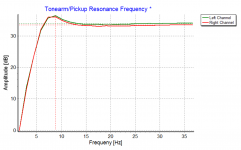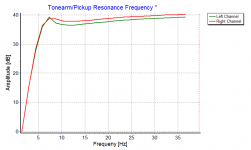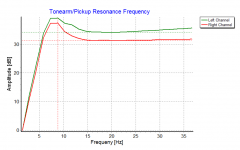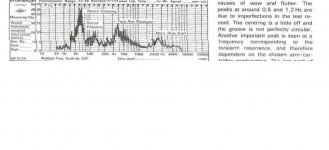about the frequencies and levels to be expected.
http://www.theanalogdept.com/images/spp6_pics/TT_Design/MechanicalResonances.pdf
George
Now that is really useful. Excellent stuff. Many thanks, George
Looks a lot like this. Below is NOT my TT, but the 10Hz spike is similar. This is "Speak to Me" from Dark Side of the Moon. If it were a blank groove the 10Hz would be the highest peak, by far.What does the spectrum look like?
I found this rip has out of phase signal < 200Hz that is 10dB under the in-phase. So far, I haven't done a good job removing it from the original.

Attachments
Looks a lot like this. Below is NOT my TT, but the 10Hz spike is similar. This is "Speak to Me" from Dark Side of the Moon. If it were a blank groove the 10Hz would be the highest peak, by far.
I found this rip has out of phase signal < 200Hz that is 10dB under the in-phase. So far, I haven't done a good job removing it from the original.
From that, it looks like the crossfeed needs to start at 100 Hz or even higher, not say at 20 Hz.
I am currently reading the very interesting B&K document that George linked to in post #401, and I've got a feeling that it will reach the same conclusion
Last edited:
As you will have gathered, I am somewhat focused on the hardware issues of Vinylising and Devinylising.
I have been Spice-prodding the Macaulay and langvad circuits, and I can share this thought:
Both circuits as published have step-like irregularities in the frequency response for in-phase signals, but in both cases tweaking a resistor value allows you to get as close to flat as you like, but the flatter you want it the more you are dealing with tiny resistance changes and this implies problems with accuracy in real life. The frequency is never inherently flat, as it is in a feedback amplifier with plenty of o/l gain. Seasoned engineers always wince when called upon to do something by cancellation, because performance is so dependent on component variations.
Bear in mind this is just tweaking one resistor; all other components are exact in sim. There are several other resistors, but worse, I think the tolerance of the capacitors in the filters will be wider than the resistors. Living in sim is instructive, but I am inclined to think that component sensitivity in practice may be a real problem if you want accurate results.
No, I don't have answer for this.
I have been Spice-prodding the Macaulay and langvad circuits, and I can share this thought:
Both circuits as published have step-like irregularities in the frequency response for in-phase signals, but in both cases tweaking a resistor value allows you to get as close to flat as you like, but the flatter you want it the more you are dealing with tiny resistance changes and this implies problems with accuracy in real life. The frequency is never inherently flat, as it is in a feedback amplifier with plenty of o/l gain. Seasoned engineers always wince when called upon to do something by cancellation, because performance is so dependent on component variations.
Bear in mind this is just tweaking one resistor; all other components are exact in sim. There are several other resistors, but worse, I think the tolerance of the capacitors in the filters will be wider than the resistors. Living in sim is instructive, but I am inclined to think that component sensitivity in practice may be a real problem if you want accurate results.
No, I don't have answer for this.
George: A most excellent find and I have learned a lot. Interesting their view of resonant frequencies. Maybe Max Townsend is right with his damping trough ideas. I have learned much this evening.
Yep... Math sucks.... 😀To exercise all codes in 16 bits you need at least 64k codes...
Sure, just remind me how I send you the url (PM no go)?Any chance I could get just one of those files to play with?
EMT 938 sample
Adobe audition has lots of versatile tools where one can remove specific frequency band rumble/noise etc. Even keep the noise and remove music content. I wonder if vertical rumble noise is taken out from music content amplify it, how it would sound. We can again add this amplified* rumble noise to music content and listen. Which I guess would help if there is anything distinct about this sound which makes vinyl listening favourable.
* Will help in evaluation if the anti-phase noise is more prominent.
Regards.
* Will help in evaluation if the anti-phase noise is more prominent.
Regards.
Cubase has filters to restore vinyl. It removes rumble if I remember correctly. It would probably be the best software to find the frequencies you are looking for.
Sent from my HTC One M9 using Tapatalk
Sent from my HTC One M9 using Tapatalk
You are welcome Douglas and Bill !
I was under the impression you had read this classic in the past but you may be younger than me (*) 😀
George
(*)58 on my back today
I was under the impression you had read this classic in the past but you may be younger than me (*) 😀
George
(*)58 on my back today
Last edited:
I think a question worth asking is why the vinyl sound is heard via a Dansette record player? It isn't close to being hi fi and is mono. The Dansette will take CD directly into it's PU input without needing EQ as the ceramic PU has mostly a flat output. This might make CD sound OK, I suspect LP will still be prefered if silly enough to play records on a Dansette ( vinyl damage is instant ). There are some things to point out. The Dansette is a nice SE class A valve amp using something like ECL82, it's far from being awful. The turntable a poormans Lenco with plenty of musical grip as German friends call it ( read EMT professional, Lenco is one of the very best sounding turntables and to me beats the SP10, I have two of those ). Ceramic PU's if they had been improved might have been best of breed. Even cheap ones have a sort of sound not unlike nice microphones, very open.
The more I think about this it's vibrato that we are talking about if anything. The resonances and tracking errors make the sound much worse ( awful is the only way to say it ). The ELP turntable has almost none worth talking about and is the nicer turntable I ever heard. Joyful for want of a better word. It has no stylus.
Most hi fi users are limited to a 40 dB dynamic range ( or much worse, 10 dB due to neighbours ? ). I suspect vinyl roar is the most likely the vinyl sound that helps. It brings up low level detail.
If this is true a nice valve compressor seems an idea. Some used selenium cells as they seemed musically to suit the requirements. I had a very long chat down the pub with a sound engineer about this, He has just bought a Lenco, A very large number of LP's and CD you own will be his work ( his desk ). He designed the digital side also ( he says clocks really matter and very clean PSU's, he wasn't just running one AtoD and DAC ). He didn't like SSL desks, but made them the best he could. They were too complicated. They were a " must have " product in the day, Whitney Houston had her own and it was one of the larger ones. They were the worlds largest single user of NE5534/32. When people hate that chip he laughs and says 90 used in the signal path at SSL. He believes the majority of CD/LP's people treasure will be SSL produced. He was No 2 engineer who did the build work. Dave Mate his boss. Dave is a real believer in analogue and a real expert with digital. He made Michael Gerzon seem not so weird. He was brought into SSL to make the sound as good as it could be. SSL had funtional excellence. It can remember any EQ/level setting and is motorised. It can fade and change functions in seconds that might take hours on another desk. Myself, I prefer the Buddy Holly sound. It takes time to set up as it's downful. It also works for classical with a little thought.
Well everybody that's all I ever learnt in terms of how this might work. My strong belief is analogue is better. LP is very poor analogue, but might be better than CD. CD is packet soup and LP home cooked food. The sad thing is no one set out to make packet soup.
The more I think about this it's vibrato that we are talking about if anything. The resonances and tracking errors make the sound much worse ( awful is the only way to say it ). The ELP turntable has almost none worth talking about and is the nicer turntable I ever heard. Joyful for want of a better word. It has no stylus.
Most hi fi users are limited to a 40 dB dynamic range ( or much worse, 10 dB due to neighbours ? ). I suspect vinyl roar is the most likely the vinyl sound that helps. It brings up low level detail.
If this is true a nice valve compressor seems an idea. Some used selenium cells as they seemed musically to suit the requirements. I had a very long chat down the pub with a sound engineer about this, He has just bought a Lenco, A very large number of LP's and CD you own will be his work ( his desk ). He designed the digital side also ( he says clocks really matter and very clean PSU's, he wasn't just running one AtoD and DAC ). He didn't like SSL desks, but made them the best he could. They were too complicated. They were a " must have " product in the day, Whitney Houston had her own and it was one of the larger ones. They were the worlds largest single user of NE5534/32. When people hate that chip he laughs and says 90 used in the signal path at SSL. He believes the majority of CD/LP's people treasure will be SSL produced. He was No 2 engineer who did the build work. Dave Mate his boss. Dave is a real believer in analogue and a real expert with digital. He made Michael Gerzon seem not so weird. He was brought into SSL to make the sound as good as it could be. SSL had funtional excellence. It can remember any EQ/level setting and is motorised. It can fade and change functions in seconds that might take hours on another desk. Myself, I prefer the Buddy Holly sound. It takes time to set up as it's downful. It also works for classical with a little thought.
Well everybody that's all I ever learnt in terms of how this might work. My strong belief is analogue is better. LP is very poor analogue, but might be better than CD. CD is packet soup and LP home cooked food. The sad thing is no one set out to make packet soup.
That B+K paper got me to dig out the resonance measurements I've done last year for a potential article (which is still very much in Status Nascenti)...
These measurements have been done with a test record through a phono pre into a sound card, and Feickert software. Note that these are cartridge/tonearm resonances - you also have tone arm resonances as such which however can be anywhere from a few 100 Hz to a few kHz or over a rather broad band.
Hope this is of some interest.
Jan
These measurements have been done with a test record through a phono pre into a sound card, and Feickert software. Note that these are cartridge/tonearm resonances - you also have tone arm resonances as such which however can be anywhere from a few 100 Hz to a few kHz or over a rather broad band.
Hope this is of some interest.
Jan
Attachments
Experimenting with the Macaulay block diagram, I find that even 2nd order Butterworth causes a mid-bass hump in the antiphase and L&R only responses, while absolutely flat for mono. This should have the effect of widening the image at the turnover frequency. I presume this places an upper limit of turnover to be below our sensitivity to direction
Jan: Whilst not wishing to steal any secrets from your article, have you worked out why you are not getting a series of peaks as the B&K testing did? Is it test method or just the arm you had flapping all over the shop?
You are welcome Douglas and Bill !
I was under the impression you had read this classic in the past but you may be younger than me (*) 😀
George
(*)58 on my back today
The fabric of space and time is particularly weak in my sector.
- Status
- Not open for further replies.
- Home
- Source & Line
- Analogue Source
- Hypothesis as to why some prefer vinyl: Douglas Self




